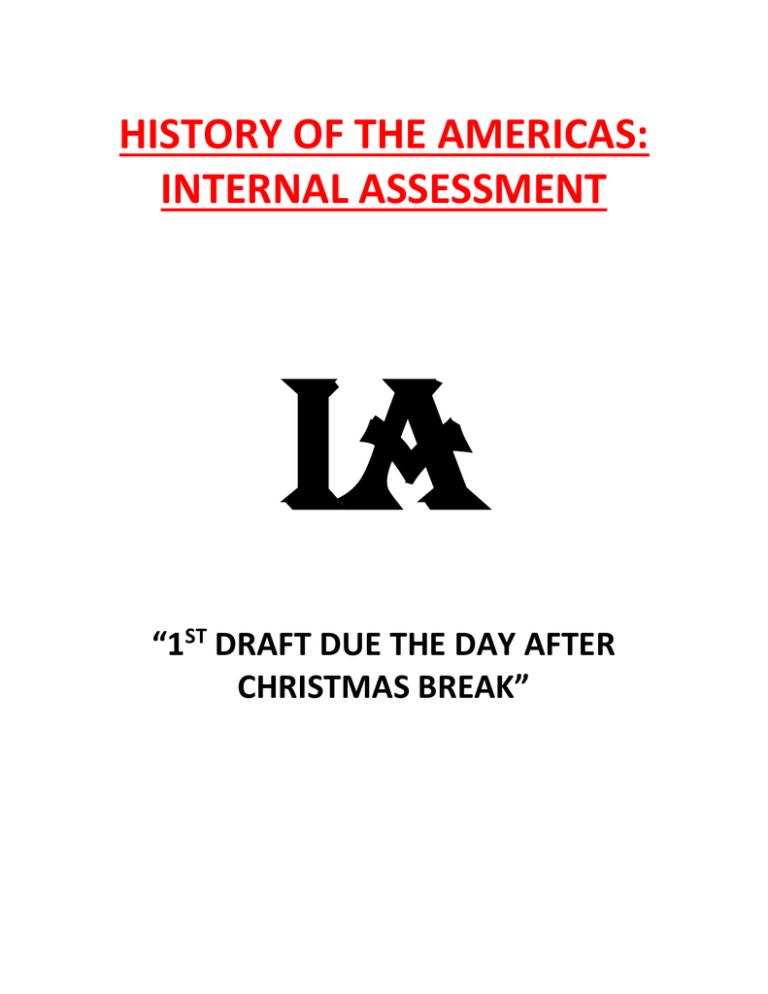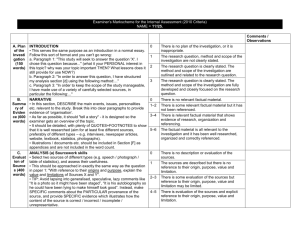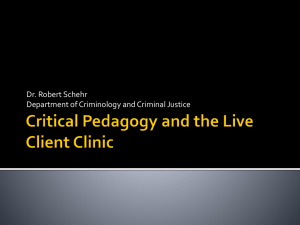File - AP World History
advertisement

HISTORY OF THE AMERICAS: INTERNAL ASSESSMENT IA “1ST DRAFT DUE THE DAY AFTER CHRISTMAS BREAK” IA REQUIREMENTS: 1. IT HAS TO BE BETWEEN 1500-2000 WORDS. EAZY PEAZY! 2. MUST STOP WITH 2006!!!!! 3. 20% OF HL GRADE/25% OF SL GRADE 4. THE EASIEST WAY TO GET IB CREDIT! SECTIONS: COVER PAGE WITH STUDENT NAME, STUDENT NUMBER, INVESTIGATION QUESTION, AND WORD COUNT PART A: YOUR PLAN OF THE INVESTIGATION PART B: SUMMARY OF EVIDENCE PART C: EVALUATION OF 2 OF YOUR BEST SOURCES USING ‘OPVL’: PART D: ANALYSIS PART E: CONCLUSION PART F: BIBLIOGRAPHY Please see below for a more detailed explanation of each of the 6 parts. UR WELCOME! PART A: THE PLAN (500 WORDS OR SO) PART A: A PLAN OF THE INVESTIGATION 1. The subject of the investigation It may be formulated as a question or just a topic like: “The relationship between sleep and doing well in IB History.” 2. You must explain the methods to be used in the investigation. This is really important. - This DOES NOT mean simply writing something like “I will use PRIMARY AND SECONDARY sources”. - You must provide a theoretical roadmap of your investigation In other words, what parts of the question will you be looking at? - Then list the different TYPES of sources (Oral interviews, biographies, newspapers etc.) - You must also write the following words: “TWO OF THESE SOURCES WILL BE EVALUATED FOR OPVL (Opinion, Purpose, Value and Limitation) MR. SHTRAKHMAN’S AWESOME EXAMPLE WAS PRESIDENT HARRY TRUMAN’S DECISION TO DROP THE ATOMIC BOMB ON HIROSHIMA AND NAGASAKI NECESSARY? The scope of my investigation will include both the practical and moral aspects of the decision. It will address the theoretical military and strategic necessity of the decision as well as the ethical questions involved. The method of my investigation from a holistic standpoint will be to explore both sides of the argument. Oral interviews with surviving members of the atomic attack, as well as memoirs from those long deceased will be taken into consideration. The military and strategic question lends itself to statistical and empirical evidence so an investigation of the historical and factual circumstances of the time is necessary. There are a plethora of statistics regarding both American and Japanese battle readiness, naval situations, past victories and defeats etc. Two of the main sources on the essay will then be interpreted according to origin, purpose, value and limitations. This last part about OPVL you must have!!!!!!!!!!!!!!!!!!!!! Booya!!!!!! (150 words. Short but sweet. Juts like me) *SO YOU SEE HOW I LAID OUT THE PLAN OFMY INVESTIGATION, NOT JUST THE TOPIC! PART B: SUMMARY OF EVIDENCE (500 WORDS) 1. This is just a basic SUMMARY of all your evidence. 2. Could be as prose or even as bullet points. (BUT NO POEMS) 3. Don’t analyze too much here, just state the facts! Your ANALYSIS OF EVIDENCE COMES IN PART D 4. TWO OF THESE PIECES OF EVIDENCE YOU WILL USE FOR SECTION C!!! 5. Your evidence may point to a couple of different possible conclusions. Could be in bullet points OR PROSE!!!!!!!!!!!!!!!!! TIPS FOR THE SUMMARY OF EVIDENCE: If you have less than 500 you probably do not have enough evidence. A. Present the most significant evidence that helps to answer your question. Non-significant evidence is a waste of words. B. In this part, you should include the basic facts related to your question. You should provide a narrative of who was involved, what happened, and when (in what sequence) the events occurred. C. You should have at least five sources, if not more. D. Make sure you present ample evidence from the two sources you'll discuss in Section C. E. You should include evidence of different possible answers. After all, a lot of questions can have more than one correct perspective. You must have evidence that considers other interpretations. ADVICE FROM IB ABOUT PART B DO NOT use judgment or analysis in this section. You will do this in Section D!!!!!!!!!!!!!!!! But you can have SOME interpretation or historical analysis. PART C: EVALUATION OF SOURCES USING ‘OPVL’ OPVL (Origin, Purpose, Value, Limitation) 1. Pick your 2 best sources. 2. 200 words for EACH source 3. You ARE NOT summarizing the sources. You are explaining their usefulness or limitations while taking their origin and purpose into consideration!!!!!!! For example, if President Bush were writing a memoir about the war in Iraq, then yes, he’s a great source but what is his true purpose. The value and limitation would flow out of that. You can use quotes, analysis, commentary, and your own intelligence (if ur lucky). OPVL (ORIGIN/PURPOSE/VALUE/ LIMITATIONS) ORIGIN: you must provide the academic credentials of the author PURPOSE: If you cannot locate a clearly articulated purpose, you may use language such as: “It appears that the author’s purpose is… VALUE: Explain why this source is valuable in general, and address why it is particularly important to your research. Make specific references to the text and its sources; use quotes. You may comment on footnotes of the book, what kinds of sources the author used, etc. LIMITATIONS: Again, you must be specific, providing examples from the text, quotes, etc. Limitations could include a critique of sources; a critique of whether or not the coverage is too broad to meet the author’s objectives; if the author is using out of date scholarship, relying on only newspaper articles, etc. Why might a historian need to show some degree of caution using this source? IB EXAMPLE: “WAS THE ALLIED BOMBING OF DRESDEN AN ACT OF TERRORISM?” McKee, Alexander. 1982. Dresden 1945: The Devil's Tinderbox. New York Written in 1982, Alexander McKee's account of the Dresden city bombings in The Devil's Tinderbox serves as an analytical assessment of the attacks. Alexander McKee is a widely published British military historian who was also a soldier with the 1st Canadian Army. He witnessed the final destruction of many towns in the name of warfare and took a special interest in the validity of the bombings of Dresden. The PURPOSE of McKee's study is mainly to analyze both sides of the argument of whether the bombings were justified. McKee examines stories as told by Dresden residents who survived the bombings. McKee also delves into official records recently declassified, to examine the political aspects of the raid. In doing this McKee is able to establish the reasons put forward for allowing the raids and the psychological effects of the raids. This document is very VALUABLE to my research. The author was actually there, and witnessed the bombings. He presents valid data including government documents that are essential to my research and analysis. Of course, his bias is also a LIMITATION. The author is clearly against the decision to carry out the bombings. It is very difficult to find information supporting the bombings. In addition, there is a lot of superfluous information unrelated to the topic at hand. This is perhaps due to the author’s writing style. PART D: ANALYSIS (500 WORDS) 1. Basically, this your bread and butter. It’s where you show the IB readers how smart you are. How well you can take your sources, take your evidence, and analyze them to ANSWER THE QUESTION. It should HINT at a conclusion, but the conclusion comes later. You can have different interpretations, and you can take the historical component into account, just make sure you can answer the question and that the evidence you have in Part B backs u up. o o o o In history, any of the following activities constitute analysis: Comparing and contrasting, differences and similarities. Explaining causation (e.g. differentiating between long-term and short-term causes, ranking causes in terms of their relative importance). Historicizing (interpreting sources within their historical context) Critically evaluating the validity of primary sources or secondary interpretations PART E: CONCLUSION (200 WORDS) PART E: CONCLUSION (150-200 WORDS) Just make sure the conclusion should is in line with the analysis and the evidence. FINAL PART: BIBLIOGRAPHY DOES NOT COUNT TOWARDS THE WORD COUNT A LIST OF SOURCES IN ALPHABETICAL ORDER. any illustrations, documents, or other supporting evidence should be included in an appendix. None of these will form part of the word count. The word count for the investigation must be clearly and accurately stated on the title page. THE ENTIRE PAPER IS DUE THE DAY WE GET BACK FROM CHRISTMAS BREAK. IT REPRESENTS 50% OF YOUR ENTIRE 3RD QUARTER GRADE AND WILL PROBABLY DETERMINE IF GET IB CREDIT FOR THIS COURSE. GOOD LUCK I WOULD LIKE IT E-MAILED. ONLY THE FINAL DRAFT WILL BE IN HARD COPY FORM If there are basic spelling and grammatical mistakes in the Rough Draft then I will assume you did not proofread the copy before you sent it to me and thus don’t really care how you write. In that case I will not give you any real assistance. YOU CAN GET A MAX OF 25 POINTS APlan of the investigation Marks Level descriptor 0 There is no plan of the investigation, or it is inappropriate. 1 The research question, method and scope of the investigation are not clearly stated. 2 The research question is clearly stated. The method and scope of the investigation are outlined and related to the research question. 3 The research question is clearly stated. The method and scope of the investigation are fully developed and closely focused on the resea BSummary of evidence Marks Level descriptor 0 There is no relevant factual material. 1–2There is some relevant factual material but it has not been referenced. 3–4There is relevant factual material that shows evidence of research, organization and referencing. 5–6The factual material is all relevant to the investigation and it has been well researched, organized and correctly referenced. CEvaluation of sources Marks Level descriptor 0 There is no description or evaluation of the sources. 1 The sources are described but there is no reference to their origin, purpose, value and limitation. 2–3There is some evaluation of the sources but reference to their origin, purpose, value and limitation may be limited. 4–5There is evaluation of the sources and explicit reference to their origin, purpose, value and limitation. DAnalysis Marks Level descriptor 0 There is no analysis. 1–2There is some attempt at analysing the evidence presented in section B. 3–4There is analysis of the evidence presented in section B and references are included. There may be some awareness of the significance appropriate, different interpretations are considered. 5–6There is critical analysis of the evidence presented in section B, accurate referencing, and an awareness of the significance to the inves different interpretations are analysed. EConclusion Marks Level descriptor 0 There is no conclusion, or the conclusion is not relevant. 1 The conclusion is stated but is not entirely consistent with the evidence presented. 2 The conclusion is clearly stated and consistent with the evidence presented. FSources and word limit Marks Level descriptor 0 A list of sources is not included or the investigation is not within the word limit. 1 A list of sources is included but these are limited or one standard method is not used consistently or the word count is not clearly and 2 A list of sources using one standard method is included and the investigation is within the word limit. 3 An appropriate list of sources, using one standard method, is included. The investigation is within the word limit. 1. - PLAN: What are you studying Which aspects of the subject Methods OPVL 2. - SUMMARY: Prose or bullet points Who, what where Difereuin evidence 3. 4. 5. 6. OPVL ANALYSIS Historical context The evidence suggests Your interpretation (What is your view of all the evidence provided in terms of answering your question Hint at conclusion CONCLUSION BIBLIO




